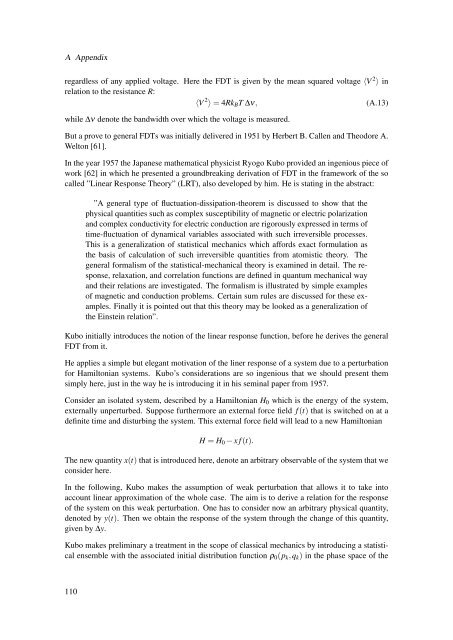Diffusion Processes with Hidden States from ... - FU Berlin, FB MI
Diffusion Processes with Hidden States from ... - FU Berlin, FB MI
Diffusion Processes with Hidden States from ... - FU Berlin, FB MI
Create successful ePaper yourself
Turn your PDF publications into a flip-book with our unique Google optimized e-Paper software.
A Appendixregardless of any applied voltage. Here the FDT is given by the mean squared voltage 〈V 2 〉 inrelation to the resistance R:〈V 2 〉 = 4Rk B T ∆ν, (A.13)while ∆ν denote the bandwidth over which the voltage is measured.But a prove to general FDTs was initially delivered in 1951 by Herbert B. Callen and Theodore A.Welton [61].In the year 1957 the Japanese mathematical physicist Ryogo Kubo provided an ingenious piece ofwork [62] in which he presented a groundbreaking derivation of FDT in the framework of the socalled ”Linear Response Theory” (LRT), also developed by him. He is stating in the abstract:”A general type of fluctuation-dissipation-theorem is discussed to show that thephysical quantities such as complex susceptibility of magnetic or electric polarizationand complex conductivity for electric conduction are rigorously expressed in terms oftime-fluctuation of dynamical variables associated <strong>with</strong> such irreversible processes.This is a generalization of statistical mechanics which affords exact formulation asthe basis of calculation of such irreversible quantities <strong>from</strong> atomistic theory. Thegeneral formalism of the statistical-mechanical theory is examined in detail. The response,relaxation, and correlation functions are defined in quantum mechanical wayand their relations are investigated. The formalism is illustrated by simple examplesof magnetic and conduction problems. Certain sum rules are discussed for these examples.Finally it is pointed out that this theory may be looked as a generalization ofthe Einstein relation”.Kubo initially introduces the notion of the linear response function, before he derives the generalFDT <strong>from</strong> it.He applies a simple but elegant motivation of the liner response of a system due to a perturbationfor Hamiltonian systems. Kubo’s considerations are so ingenious that we should present themsimply here, just in the way he is introducing it in his seminal paper <strong>from</strong> 1957.Consider an isolated system, described by a Hamiltonian H 0 which is the energy of the system,externally unperturbed. Suppose furthermore an external force field f (t) that is switched on at adefinite time and disturbing the system. This external force field will lead to a new HamiltonianH = H 0 − x f (t).The new quantity x(t) that is introduced here, denote an arbitrary observable of the system that weconsider here.In the following, Kubo makes the assumption of weak perturbation that allows it to take intoaccount linear approximation of the whole case. The aim is to derive a relation for the responseof the system on this weak perturbation. One has to consider now an arbitrary physical quantity,denoted by y(t). Then we obtain the response of the system through the change of this quantity,given by ∆y.Kubo makes preliminary a treatment in the scope of classical mechanics by introducing a statisticalensemble <strong>with</strong> the associated initial distribution function ρ 0 (p k ,q k ) in the phase space of the110









